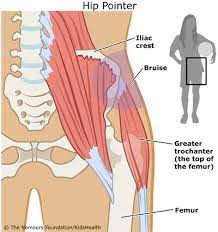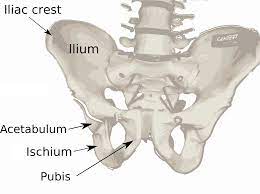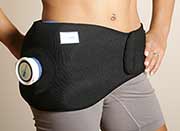What is a Hip pointer?
Last Updated on August 12, 2024 by The SportsMD Editors
A hip pointer is a contusion, or bruise, of the iliac crest, the bone along the brim of the pelvis, and its surrounding structures. Other affected structures may include the tensor fascia lata, the external oblique muscle and the greater trochanter of the femur. In severe cases a hematoma, a collection of blood, may form and cause a palpable fluctuant mass beneath the skin. Hip pointers are usually the result of a direct blow to the pelvic brim, often in contact sports like football or ice hockey, or after a fall directly onto the hip.
Symptoms of hip pointer
A hip pointer is associated with pain over the iliac crest, bruising and hematoma may also occur, as may muscle spasm. In the case of a hematoma, a hip pointer may be associated with severe pain, as it dissects between the gluteus muscle and the iliac crest and can potentially press on the femoral or lateral femoral cutaneous nerves.
Diagnosing a hip pointer
 While a hip pointer may be diagnosed clinically, in certain instances additional information may be garnered from imaging. Radiographs help to make sure that no fractures have occurred, while MRI and ultrasound may be used to determine the extent of the contusion and or hematoma present. X-rays are especially important in the adolescent patient who may have an avulsion fracture that mimics a hip pointer clinically.
While a hip pointer may be diagnosed clinically, in certain instances additional information may be garnered from imaging. Radiographs help to make sure that no fractures have occurred, while MRI and ultrasound may be used to determine the extent of the contusion and or hematoma present. X-rays are especially important in the adolescent patient who may have an avulsion fracture that mimics a hip pointer clinically.
Anatomy of the pelvic brim

The pelvic brim, or iliac crest, is the very superficial bony prominence felt beneath the skin on one’s side at the level of the belly button. It is a part of the pelvis girdle, and has attachments for many muscles, including the internal and external obliques, the tensor fascia lata, the gluteus medius, the latissimus dorsi, and the paraspinal muscles.
Treatment for Hip pointer
The acute treatment of a hip pointer includes rest, ice and use of anti-inflammatory medications like ibuprofen or naproxen.

Crutches may be needed for a couple of days after injury. It has been suggested to delay treatment, other than with ice, for 48 hours to allow all bleeding to stop prior to treating a deep contusion any further. An acute injection of corticosteroids (ie hydrocortisone) into the injured area may greatly reduce symptoms in the short term and speed up rehabilitation. There is however the risk of disordered muscle healing after corticosteroid injection, and as such decision to use this modality must be made on a case specific basis, with the athlete’s best interest in mind. Needle aspiration, or draining of, a painful hematoma may improve symptoms and decrease time to recovery. Physical therapy may be needed to regain motion and strength prior to return to play.
Home Remedies
There are several home remedies that can help alleviate hip pointer pain, such as P.R.I.C.E Treatment:
- Protection: The purpose of protection is to avoid further injury to the area by protecting the injured structures. The type of protection used varies depending on the injured area but may include an ace bandage, protective tape, or over-the-counter hip brace.
- Rest: The purpose of resting is to allow the body’s own healing processes to naturally occur without being impeded by movement of the injured area. Any increase in movement of an injured tissue results in increased circulation to the area which in turn may result in further damage to the injured tissue and/or increased swelling.
- Ice: Ideally, ice packs are made of crushed ice because the crushed ice is more comfortable for the athletes and conforms to the contours of the injured area better than cubed ice. Ice can be placed into plastic or Ziploc bags. A light barrier should be placed between the skin and the ice bag (paper towel) to prevent injury to the skin during the application of the ice.
The ice pack can be secured with an ace bandage if needed. The ice should be applied for 20 minutes at a time and then removed. This can be repeated every two hours while the athlete is awake.
- Compression: When the ice pack is removed, a compression wrap should be applied to the injured area. The compression wrap serves as a mechanical barrier so that swelling is minimized in the injured area. There are a number of compression wraps available on the market, but the most commonly used is an elastic or ace bandage.
- Elevation: Elevation is important immediately post-injury to reduce the amount of blood flow to the injured area. For the lower extremities, the athlete can elevate his/her leg by lying down and elevating the injured limb on pillows. The key is that the athlete needs to have the injured area above his/her heart level.
Following the PRICE principles is an effective way to minimize the swelling in an injured area so that the athlete can return to play quickly.
Hip pointer injury recovery time
Return to play ranges based on the severity of injury, and treatment modalities used. Once pain free gait has been resumed sports specific training can be initiated. With conservative treatment and physical therapy, on average one can expect full recovery within two to four weeks. and longer still if there’s a fracture to the bone. After full healing, you should expect to be able to participate in full activity without restrictions. An injured athlete may return to play once full range of motion and strength have returned.
Complications of a hip pointer
Potential complications include muscle fibrosis, delayed muscle soreness, and myositis ossificans (bone formation after hematoma within a muscle).
How can an athlete prevent a hip pointer?
Proper fitting padding and protective equipment can help prevent injury occurrence or recurrence.
Get a Virtual Sports Specialized appointment within 5 minutes for $29
 When you have questions like: I have an injury and how should I manage it? How severe is it and should I get medical care from an urgent care center or hospital? Who can I talk to right now? SportsMD Virtual Urgent Care is available by phone or video anytime, anywhere 24/7/365, and appointments are within 5 minutes. Learn more via SportsMD’s Virtual Urgent Care Service.
When you have questions like: I have an injury and how should I manage it? How severe is it and should I get medical care from an urgent care center or hospital? Who can I talk to right now? SportsMD Virtual Urgent Care is available by phone or video anytime, anywhere 24/7/365, and appointments are within 5 minutes. Learn more via SportsMD’s Virtual Urgent Care Service.
FAQs
Question: What does a hip pointer feel like?
Answer: With a hip pointer you can feel immediate and often excruciating pain. After the intial injury, you will feel pain and tenderness when pressing in over the bony part at the front of your hip. Bruising and swelling can also be present.
Question: How long does it take a hip pointer to heal?
Answer: Return to play ranges based on the severity of injury, and treatment modalities used. With conservative treatment and physical therapy, on average one can expect full recovery within two to four weeks but longer still if there’s a fracture to the bone.
Question: Should I stretch a hip pointer?
Answer: Gentle stretching a hip pointer for 20-30 seconds can help to loosen the muscles around the injured hip and help reduce pain. Your doctor or phsyical therapist may percribe a full rehabilitation program wich would include stretching and mobility exercises followed by hip strengthening exercises.
Hip pointer for Nathan Brown, mechanism looks non-contact but collision to hip prior to this would have caused the damage. Effectively is a bad cork to the point of the hip. Looks a lot worse than it is, usually worst case 2-4 weeks. Some even able to return within a week pic.twitter.com/kvh3czzdXk
— NRL PHYSIO (@nrlphysio) May 1, 2021
References:
- Anderson, K., S. M. Strickland, and R. Warren. “Hip and Groin Injuries in Athletes.” Am J Sports Med 29 4 (2001): 521-33. Print.
- Arendt, Elizabeth A., American Orthopaedic Society for Sports Medicine., and American Academy of Orthopaedic Surgeons. Oku Orthopaedic Knowledge Update. Sports Medicine 3. 3rd ed. Rosemont, IL: American Academy of Orthopaedic Surgeons, 2004. Print.
- DeLee, Jesse, David Drez, and Mark D. Miller. Delee & Drez’s Orthopaedic Sports Medicine : Principles and Practice. 3rd ed. Philadelphia: Saunders/Elsevier, 2010. Print.

